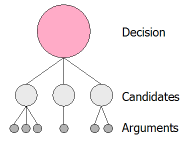Decisions, Candidates and Arguments: Overview
![]() Decisions: Creating a decision based on results of an enquiry
Decisions: Creating a decision based on results of an enquiry
Decisions are tasks in which a choice is made – either by the Tallis Engine or by the end-user – between several different options, known as candidates. PROforma supports decision-making through a mechanism for generating arguments that may be either for or against a given candidate.
The figure below describes the structure of a decision: candidates are a property of a decision, and arguments are assigned to each candidate.

An argument is defined by two components:
| Condition | A truth-valued expression that represents the circumstances under which the argument applies (e.g.: blood_pressure < 120). |
| Support | The support that the argument offers the candidate if the condition is true. The support format can be either symbolic or numeric:
|
When a decision is enacted, the condition and the support properties are used by the Tallis Engine to determine the effect of each argument and in turn the aggregated effect for a given candidate. The aggregated support of all of a candidate’s arguments is known as netsupport.
A recommendation rule is then used to determine whether or not a particular candidate is recommended. The rule defines an expression that must be true for the candidate to be recommended; this expression typically takes into account the candidate’s netsupport.
Note
- End-users can select non-recommended candidates if they wish.
- One or more candidates can be selected if the candidate selection mode of the decision is multiple selection.
Learn more about:
Browse through process-description samples:
If you have installed the Tallis Toolset, you can find these samples in the World > Samples folder in the ACL Web Repository.
- Cold And Flu Guide
 Run this sample file
Run this sample file- Click here for a detailed description of this sample.
- Chronic Cough
 Run this sample file
Run this sample file- Click here for a detailed description of this sample.
- Hypertension
 Run this sample file
Run this sample file- Click here for a detailed description of this sample.
- Triple Assessment
 Run this sample file
Run this sample file- Click here for a detailed description of this sample.
